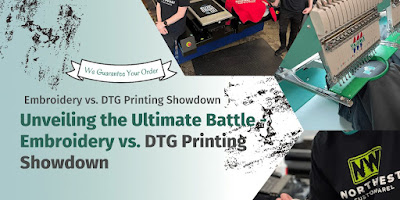Embroidery vs DTG Printing: Unraveling the Threads of Textile Decoration
Embroidery and Direct-to-Garment (DTG) printing are two popular methods for adding designs to clothing. Each technique has its own set of characteristics, advantages, and limitations. Our team of experts has put together a comprehensive guide to help you understand the intricacies of Embroidery vs DTG Printing, enabling you to make an informed choice for your specific requirements.
Embroidery: A Timeless Craft
Tradition Meets Modernity:
Embroidery is an ancient art form that has seamlessly transitioned into the modern world. This traditional method involves stitching intricate designs onto fabric using needles and threads. It adds a touch of elegance and permanence to garments.
Texture and Dimension:
One of the standout features of embroidery is the three-dimensional texture it imparts to designs. The raised surface creates a tactile and visually appealing effect, making it ideal for logos, monograms, and intricate patterns.
Durability:
Embroidery is renowned for its durability. The stitched designs withstand regular wear and tear, making it a preferred choice for workwear, uniforms, and items that require frequent washing.
Material Versatility:
Whether it's cotton, denim, or fleece, embroidery adapts well to a variety of fabrics. This versatility makes it suitable for a broad spectrum of apparel, from casual t-shirts to professional polo shirts.
DTG Printing: High-Tech Precision
Digital Precision:
DTG Printing represents the cutting edge of apparel customization. Utilizing digital technology, this method prints vibrant and detailed designs directly onto fabric. It's a boon for intricate, colorful artwork and photorealistic images.
Unlimited Color Palette:
Unlike traditional printing methods, DTG allows for an extensive color palette without additional costs. This makes it an ideal choice for designs with multiple colors, gradients, and shades, providing a broad spectrum of creative possibilities.
Small Batch Efficiency:
DTG Printing is highly efficient for small batch production. Whether you need a limited run of custom-designed shirts for an event or a unique gift, DTG is cost-effective for low-quantity orders.
Soft Feel:
The ink used in DTG Printing is water-based, resulting in a soft and breathable finish. The printed design becomes an integral part of the fabric, ensuring comfort without compromising on style.
Choosing Between Embroidery and DTG Printing:
Design Complexity:
If your design involves intricate details, gradients, and a wide range of colors, DTG Printing is the superior choice. However, if you prefer a textured, classic look, embroidery might be more suitable.
Quantity and Budget:
For large quantities and budget constraints, DTG Printing offers a cost-effective solution. Embroidery, on the other hand, is more economical for smaller batches.
Fabric Type:
Consider the fabric of your garments. While embroidery suits various fabrics, DTG Printing is particularly effective on cotton and blends.
Purpose and Durability:
Evaluate the purpose of your apparel. If longevity and durability are crucial, especially for work or sports uniforms, embroidery is the preferred option.
In the realm of textile decoration, two prominent techniques stand out: embroidery and direct-to-garment (DTG) printing. Each method has its unique characteristics, advantages, and applications, making them suitable for various purposes. This guide aims to unravel the threads of embroidery and DTG printing, providing a comprehensive comparison to help you make informed decisions for your personalized garment projects.
Embroidery:
- Definition: Embroidery is a traditional technique that involves stitching a design onto fabric using threads or yarns.
Advantages:
- Durability: Embroidered designs tend to be more durable and long-lasting, making them ideal for workwear or items subjected to frequent washing.
- Texture and Depth: The three-dimensional texture of embroidery adds depth and a tactile quality to the design, enhancing its visual appeal.
- Wide Material Compatibility: Embroidery can be applied to various materials, including cotton, denim, and even leather.
DTG Printing:
- Definition: DTG printing is a modern, digital printing method that directly applies ink onto the fabric's surface using specialized printers.
Advantages:
- High Detail Reproduction: DTG printing excels at reproducing intricate details and complex designs with a high level of precision.
- Color Variety: This method offers a wide range of color options, enabling vibrant and detailed prints with gradients and shading.
- Versatility: DTG printing is suitable for a variety of fabrics, including cotton, polyester, and blends, providing flexibility in material selection.
Comparative Analysis:
- Embroidery: Generally, embroidery can be more expensive, especially for designs with a high stitch count or intricate details.
- DTG Printing: Cost-effective for small to medium-sized orders, DTG printing allows for cost savings without compromising on quality.
Turnaround Time:
- Embroidery: The intricate nature of embroidery can result in longer turnaround times, especially for complex designs.
- DTG Printing: Known for its quick production, DTG printing is ideal for projects with tight deadlines.
Design Complexity:
- Embroidery: Well-suited for simple logos and text, embroidery may struggle with highly detailed or complex designs.
- DTG Printing: Excels at reproducing intricate and complex designs, making it a preferred choice for detailed artwork and photographs.
Conclusion:
In the embroidery vs DTG printing debate, the choice ultimately depends on your specific needs and preferences. If you value durability, texture, and a traditional aesthetic, embroidery might be your go-to. On the other hand, if you prioritize high-detail reproduction, color variety, and a quicker turnaround, DTG printing could be the perfect fit.




Comments
Post a Comment